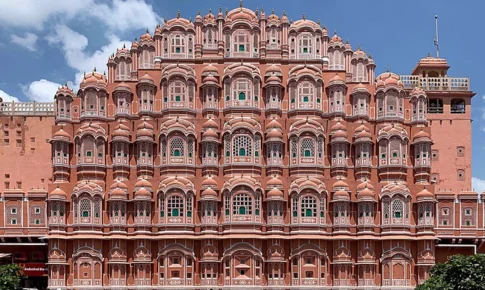Places to Visit in Jaipur
Amer Fort: Amer Fort, also known as Amber Fort, is a magnificent palace complex located about 11 kilometers from Jaipur. Built in the 16th century by Raja Man Singh I, the fort showcases a blend of Hindu and Mughal architectural styles. The fort is perched on a hill and overlooks Maota Lake, offering breathtaking views. Visitors can explore the stunning courtyards, palaces, and halls, including the Diwan-i-Aam (Hall of Public Audience), Diwan-i-Khas (Hall of Private Audience), Sheesh Mahal (Mirror Palace), and the Sukh Niwas (Hall of Pleasure). The fort's intricate mirror work, frescoes, and carvings are truly captivating. A popular way to reach the fort is by elephant ride, although jeeps are also available. The evening sound and light show narrates the history of Amer Fort and the city, making it a memorable experience.
City Palace: The City Palace, located in the heart of Jaipur, is a splendid complex of palaces, courtyards, and gardens that served as the seat of the Maharaja of Jaipur. Constructed in 1727 by Maharaja Sawai Jai Singh II, the palace blends Rajput, Mughal, and European architectural styles. The City Palace houses several structures, including the Chandra Mahal, Mubarak Mahal, and Diwan-i-Khas. The Chandra Mahal is still the residence of the royal family, and parts of it have been converted into a museum showcasing royal artifacts, textiles, manuscripts, and paintings. The Diwan-i-Khas, with its beautiful crystal chandeliers and two sterling silver vessels, is a sight to behold. The palace also features the Peacock Gate, known for its vibrant colors and intricate designs, and the Pritam Niwas Chowk, a courtyard with four gates representing the four seasons.
Hawa Mahal: Hawa Mahal, or the "Palace of Winds," is one of Jaipur's most iconic landmarks. Built in 1799 by Maharaja Sawai Pratap Singh, this five-story structure is constructed of red and pink sandstone. The palace's unique facade, resembling the honeycomb of a beehive, features 953 small windows, or jharokhas, adorned with intricate latticework. These windows allowed royal ladies to observe street festivities without being seen, adhering to the purdah system. The Hawa Mahal is designed to provide natural ventilation, ensuring a cool breeze flows through the palace even during the hot summer months. Visitors can climb to the top for panoramic views of the city and explore the small museum inside that showcases artifacts related to Jaipur's history.
Jantar Mantar: Jantar Mantar is an astronomical observatory built by Maharaja Sawai Jai Singh II in the early 18th century. This UNESCO World Heritage site houses a collection of 19 architectural astronomical instruments, including the world's largest stone sundial, the Samrat Yantra. These instruments were designed to measure time, predict eclipses, track stars, and ascertain celestial altitudes. The precision and scale of these structures demonstrate the advanced scientific knowledge of the period. Visitors can take guided tours to understand the functioning and significance of each instrument. Jantar Mantar offers a fascinating glimpse into the astronomical advancements of medieval India.
Jal Mahal: Jal Mahal, meaning "Water Palace," is a stunning palace situated in the middle of Man Sagar Lake. Built in the 18th century by Maharaja Madho Singh I, the palace is a blend of Rajput and Mughal architectural styles. The five-story structure has four floors submerged underwater when the lake is full, leaving only the top floor visible. The serene setting and the reflection of the palace in the water create a picturesque scene, especially at sunset. While the interior of Jal Mahal is not open to the public, visitors can enjoy boat rides on the lake and view the palace from a distance. The surrounding area is also a popular spot for birdwatching, with many migratory birds frequenting the lake.
Tips For Self drive car in Jaipur
Compare Prices: At Carsavaar, we believe in being clear and open. This means you can easily check the prices for our different Self drive car in Jaipur. Whether you want a basic car, a big SUV, or a fancy one, we have good prices that match your budget.
Advance Booking: To make your rental process smooth and easy, think about booking your Self drive car in Jaipur ahead of time with Carsavaar. When you plan your trip in advance, you can make sure the car you want is ready for you when you get there. It doesn't matter if you're traveling for work or fun, our website is easy to use, so you can book a car fast and with no trouble.
Research: At Carsavaar, we know that doing good research is super important when you're renting Self drive car in Jaipur. We want our customers to be smart about their choices, so we recommend looking at all the options carefully. Our website is easy to use, and it has lots of info about our cars, rules, and prices. This makes it simple for you to compare and pick the right car for your trip.
Vehicle Selection: When you pick Carsavaar, you get to decide which car suits your trip best, making it comfy and unforgettable. Your adventure begins with choosing the right car, and we're here to help you make the perfect choice for your needs.
Insurance Coverage: When you go with Carsavaar for renting Self drive car in Jaipur, you're not just getting a good car, but also the comfort of knowing you're well-protected. We really care about your safety on the road. Our insurance plans are made to keep you safe during your Self drive car in Jaipur time.
Check Rental Terms: Before you start your trip with Carsavaar, it's really important to look closely at and know our Self drive car in Jaipur rules. We believe in being clear and making sure you know what you're getting into. When you check our Self drive car in Jaipur terms, you'll know stuff like how long you can rent, how far you can drive, the fuel rules, and what to do when you return the car. It helps you stay informed and avoid surprises.
NOTE-This is an estimated vehicle quotation. The final quotation will be confirmed once you provide us with your trip details and finalize your vehicle selection.



